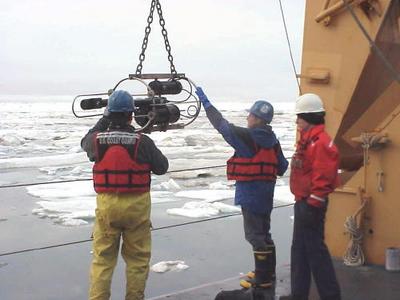
|
|
21 July, 2002
Once again, it’s tough to say when my day actually
started. Officially it was at midnight when most of
the scientists were still up working because we had
finally reached our 4:30 PM station at 10:30 PM! We
headed on deck for the first of our five van Veen
grabs around 1:30 AM. We had moved north along the
coast and were in Barrow Canyon, part of the shelf,
the gently sloping area just off the coast. Remember
that this project is examining the shelf-basin
interaction. Although we were still sampling in
relatively shallow water (around 50 meters), there is
a strong current that runs through the area. As a
result, our first and second grabs pulled up mostly
rocks and very little mud. We decided to call it a
night and I got to bed by 3 after posting my journals
and pictures. (Note: there were lots of people still
in the lab when I went to bed!) By the way, there is
a wonderful website where you can follow the ship’s
cruise path, get great satellite photos of the ice
distribution and even follow my journal. The site is
http://www.joss.ucar.edu/sbi/catalog.
Because the Sunday schedule is considered a holiday
schedule for the crew, brunch is served in place of
breakfast and lunch. Everyone got a few extra hours
of sleep after their late night/early morning. By the
way, for those of you who read yesterday’s journal,
you will be happy to know that Cindy got her
instruments working and ran a very successful first
sample analysis. Someone else was able to get his
equipment up and running for the first time yesterday
as well, and the team deploying the video plankton
recorder was pleased to get results early this morning
after an unsuccessful earlier attempt. Transporting
sensitive equipment, setting it up, and actually
making it work at sea is a difficult proposition. It
continually amazes me to see the complex procedures
going on all around me.
My “day” ended at 6 AM on the 22nd when we finished
processing the samples from the van Veen grabs and the
Haps core (I’ll have a picture and description for you
tomorrow.) Part of our problem was the fact that the
sampling area included tremendous numbers of mussels,
a type of bivalve (bi = two and valve = shell).
Mussels are known for the incredibly strong byssal
threads they use to attach themselves to rocks. They
are also filter feeders, filtering the water for tiny
organisms. The current that brings the nutrients to
this area also makes it necessary for the mussels to
use byssal threads to hang onto rocks on the bottom.
It was these same threads that made our sieving so
difficult. While earlier grabs could be sieved in
less than 10 minutes, each of these took nearly 45
minutes even with two of us working!
The excitement of the day was the arrival of Dr.
Jackie Grebmeier, co-chief scientist and the woman
with whom I am working. Most of the scientists know
Jackie as does many of the crew, and everyone was
happy to see her arrive. Her arrival and that of
three people from CBS news stopped all outside work on
the aft (back portion) of the ship. They are all
important people, but that’s not the reason the work
stopped. Whenever a helicopter takes off or lands, we
hear “stand by for flight con (condition) one.”
Everyone in the back of the ship immediately moves
inside and takes in any clothing or equipment that
could be caught up in the helicopter blades. Once the
helicopter has taken off, we hear “stand by for flight
con 2” and work returns to normal.

Dr. Jackie Grebmeier arrived on board the Healy today. She has just completed a 10 day cruise on the Canadian ship, the Sir Wilfred Laurier.

Despite previous problems the VPR (Video Plankton Recorder) worked this time.

If you are on deck when equipment is in use, you must wear a hard hat. Other hard hat names include Live Bering, Roller Bering, and Bering Gifts. Check the cruise route on my main web page to see our path through Bering Strait.
Contact the TEA in the field at
.
If you cannot connect through your browser, copy the
TEA's e-mail address in the "To:" line of
your favorite e-mail package.
|
